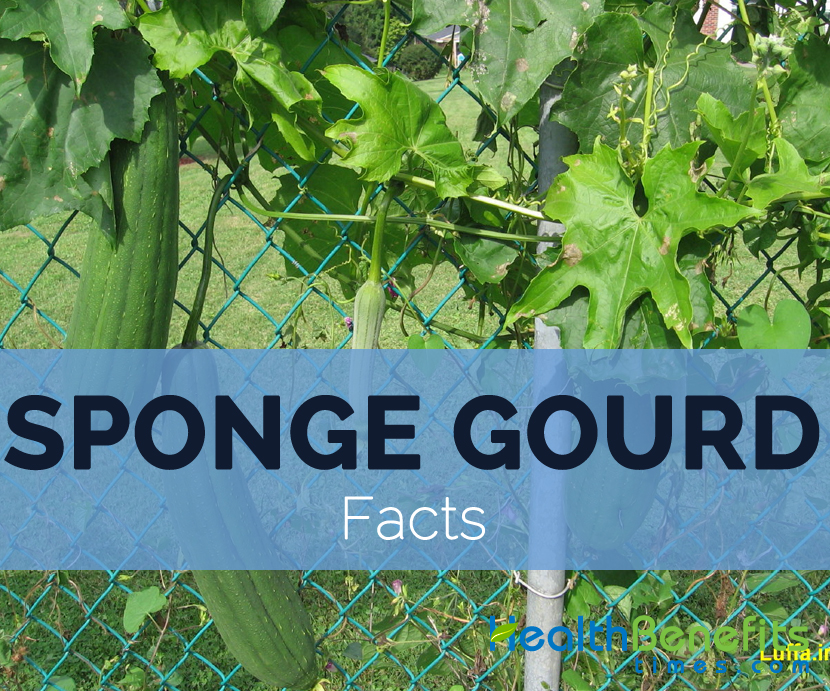
| Name | Sponge gourd |
|---|---|
| Scientific Name | Luffa aegyptiaca |
| Native | Tropical Africa and Asia but now grown throughout Asia and the United States for food and scrubbers. |
| Common/English Name | Common Luffa, Bath Sponge, Dish Cloth Gourd, Sponge Gourd, Dish-Cloth Gourd, Towel Gourd, Dishrag Gourd, Vegetable Sponge, Rag Gourd, Wash-Rag Sponge, Smooth Luffa, Scrubber Gourd, Wild Vegetable Sponge |
| Name in Other Languages | Arabic: Luff, Lûf; Bangladesh: Dhundol; Bolivia: Estropajo; Brazil: Bucha, Gonçalinho; Chinese: Si Gua, Shui Gua; Chuukese: Mororof; Columbia: Estropajo; Cook Islands (Maori): Pō‘Ue, Puru; Czech: Tivuk Egyptský, Lufa Válcovitá; Danish: Egyptisk Luffa, Vegetabilsk Svamp; Dutch: Loofah, Sponskomkommer; French: Courge Cylindrique De Chine, Eponge Végétale; German: Luffa, Netzgurke; Guatemala: Estropajo; Honduras: Estropajo; Hungarian: Halostök, Szivacstök; India:- Assamese: Bhatkakrel, Bhol, Bengali: Dhundul, Hastighasha, Hindu: Dhodka, Ghia-Torai, Kannada: Araheere, Tuppahire, Malayalam: Cattu-Picinna, Puttilpiram, Manipuri: Shebot, Marathi: Ghadaghosali, Paroshi, Sanskrit: Dhamargava, Sapitaka, Tamil: Mulukkupperakkai, Vatukikam, Telugu: Netibirakaya, Neti Beera; Indonesia:– Javanese: Blestru, Blustru, Madurese: Bludru, Ghludhru, Malay: Blustru, Sundanese: Bulustu, Emes, Sumatran: Ketola, Hurunh Jawa; Italian: Luffa, Zucca Da Spunge; Japanese: Hechima, Naga Ito-Uri; Khmer: Ronôông Muul; Korean: Su Sa Mi Oe; Laotian: Mak Bouap, Bwàp Khôm; Malaysia: Ketola Manis, Petola Buntal; Mauritius:– French: Courge Torchon, Pétole; Mexico: Estropajo Nepal: Palo, Ghiu Toriya; Nicaragua: Estropajo; Pakistan: Ghia Tori; Panama: Estropajo Peru: Estropajo; Persian: Khujar; Philippines :- Bisaya: Tabobog, Patola, Bikol: Patola, Bontok: Kabatiti, Iloko: Tabau-Tabau, Kabatiti-Aso, Spanish: Pepinillo De San Gregorio, Sulu: Patula-Amu, Tagalog: Patola, Tabobog; Polish: Trukwa Egipska; Portuguese: Lufa, Fruta Dos Paulistas; Samoan: Meleni Vao; Russian: Ljufa; Spanish: Esponja, Paste; Sri Lanka (Sinhala) : Vatakolu; Swedish: Luffa; Tahitian: Aroro, Huerhaho; Thai: Buap-Rom, Buap- Klom; Tibetan: Ra Dza Ko Sa Ta Ki; Tongan: Fangu ‘A Kuma, Mafa‘I; Turkish: Luf; Uganda (Luganda): Kyangwe, Runyoro, Rutooro: Ekyangwe; Venezuela: Estropajo; Vietnam: Mướp Hương; Wallisian: Mafa‘I |
| Plant Growth Habit | Annual vine, coarse, vigorous, monoecious |
| Growing Climate | Tropical and subtropical |
| Soil | Well-drained |
| Plant Size | 30 ft. (9 m) long |
| Stem | Five angled stems |
| Leaf | Ovate-reniform, dark green with silvery patches topside |
| Edible parts of the plants | Fruit, flowers and leaves: It is used as a vegetable which is prepared like squash or consumed raw as cucumbers. Flowers buds: It is used as vegetables. Young fruit: It is boiled with coconut milk by slicing for sambal or sayur. Seeds: It is prepared with salt and consumed by roasting as a delicacy. |
| Flowering Season | Summer |
| Flower | Yellow, monoecious, diameter: 5-7.5 cm |
| Fruit shape & size | Cylindrical, smooth, fusiform, length: 24 in (61 cm) and diameter: 3 in (7.6 cm); |
| Fruit color | Green |
| Flesh color | White |
| Fruit peel | Thin and smooth |
| Fruit Taste | Resemble zucchinis |
| Seed | Flat ovate, smooth, black, 1–12 cm long |
| Varieties/Types | Angled luffa, Smooth luffa, Taiwan luffa |
| Fruit Season | Long season |
| Major Nutritions | Vitamin A 463 µg (66.14%) Carbohydrate 25.53 g (19.64%) Vitamin B5 (Pantothenic acid) 0.892 mg (17.84%) Manganese, Mn 0.397 mg (17.26%) Potassium, K 806 mg (17.15%) Copper, Cu 0.151 mg (16.78%) Total dietary Fiber 5.2 g (13.68%) Vitamin B6 (Pyridoxine) 0.176 mg (13.54%) Vitamin C (Ascorbic acid) 10.1 mg (11.22%) Magnesium, Mg 36 mg (8.57%) Iron, Fe 0.64 mg (8.00%) Phosphorus, P 55 mg (7.86%) Vitamin B1 (Thiamin) 0.082 mg (6.83%) Vitamin B2 (Riboflavin) 0.075 mg (5.77%) Vitamin B9 (Folate, Folic acid) 21 µg (5.25%) |
| Health Benefits |
|
| Calories in 1cup (178 gm) | 100 Kcal. |
| Traditional uses |
|
| Precautions | Luffa is safe in food amounts for pregnant and breast-feeding women whereas the intake in huge amounts should be avoided. |
| How to Eat |
|
| Other Facts |
|
Comments
comments